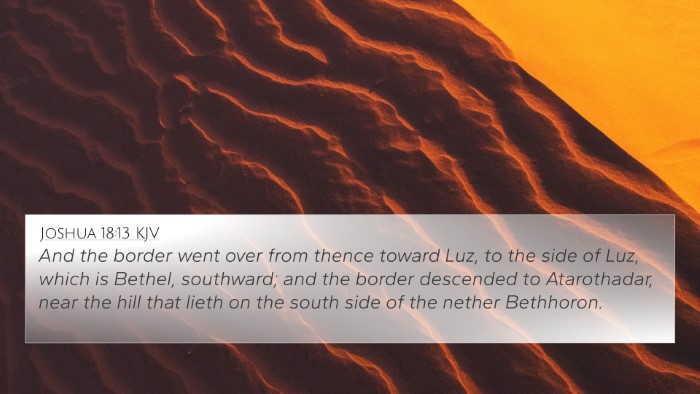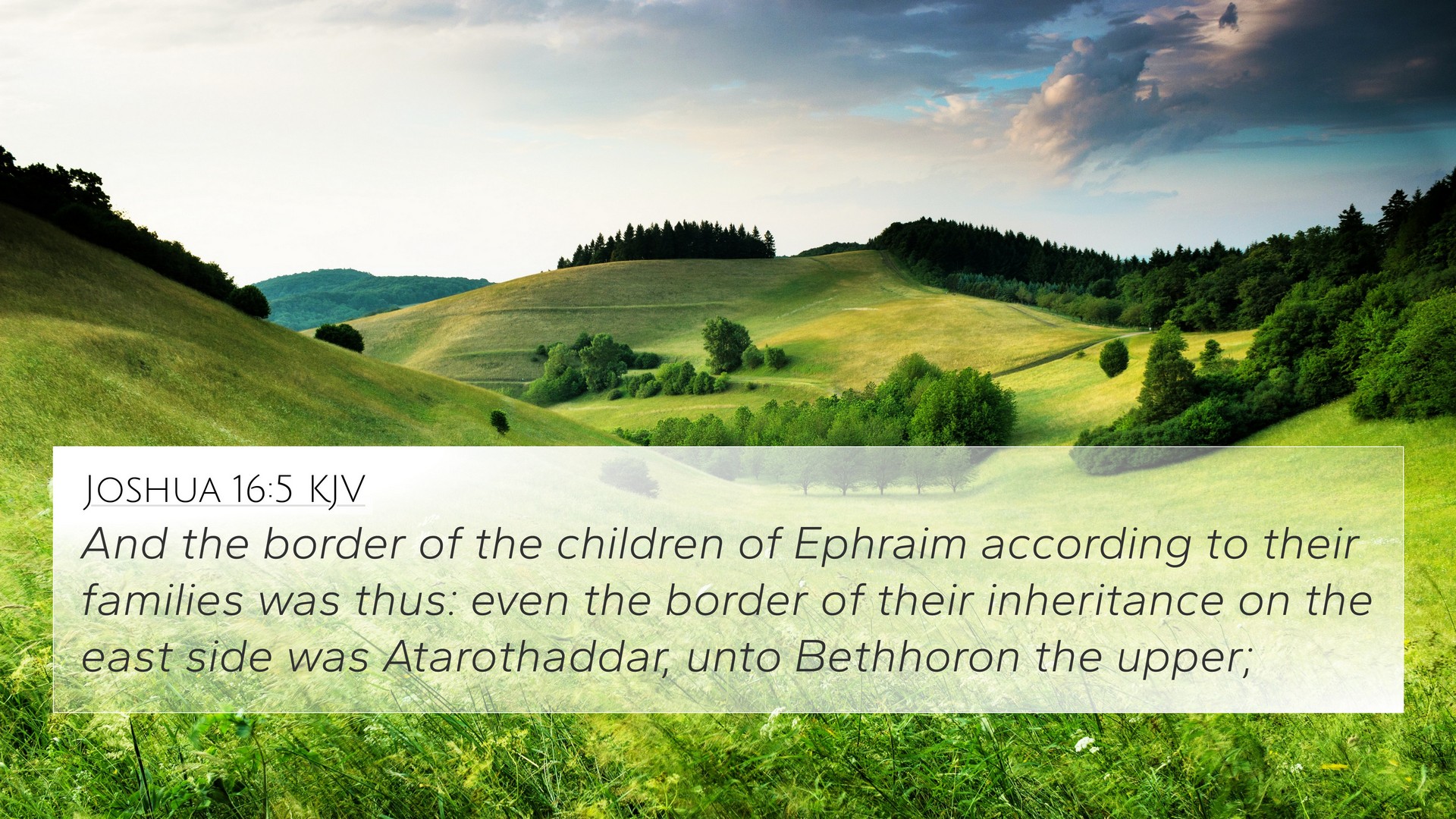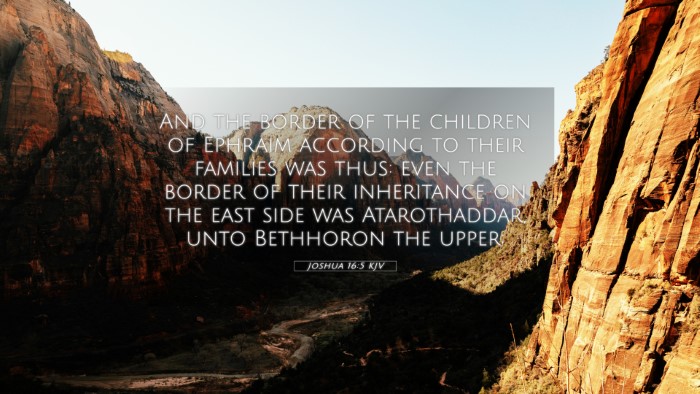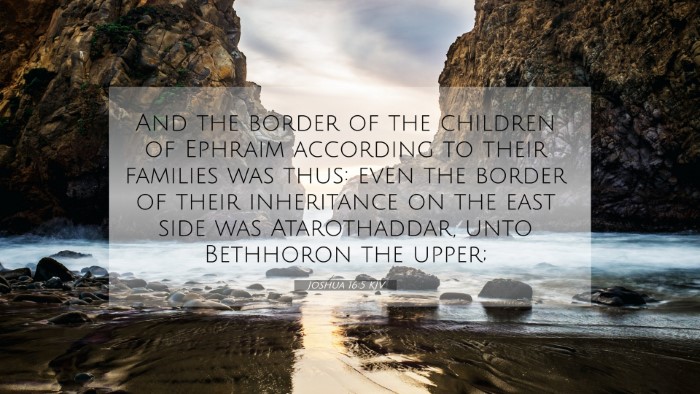Old Testament
Genesis Exodus Leviticus Numbers Deuteronomy Joshua Judges Ruth 1 Samuel 2 Samuel 1 Kings 2 Kings 1 Chronicles 2 Chronicles Ezra Nehemiah Esther Job Psalms Proverbs Ecclesiastes Song of Solomon Isaiah Jeremiah Lamentations Ezekiel Daniel Hosea Joel Amos Obadiah Jonah Micah Nahum Habakkuk Zephaniah Haggai Zechariah MalachiJoshua 16:5 Similar Verses
Joshua 16:5 Cross References
And the border of the children of Ephraim according to their families was thus: even the border of their inheritance on the east side was Atarothaddar, unto Bethhoron the upper;
Uncover the Rich Themes and Topics of This Bible Verse
Listed below are the Bible themes associated with Joshua 16:5. We invite you to explore each theme to gain deeper insights into the Scriptures.
Joshua 16:5 Cross Reference Verses
This section features a detailed cross-reference designed to enrich your understanding of the Scriptures. Below, you will find carefully selected verses that echo the themes and teachings related to Joshua 16:5 KJV. Click on any image to explore detailed analyses of related Bible verses and uncover deeper theological insights.

Joshua 18:13 (KJV) »
And the border went over from thence toward Luz, to the side of Luz, which is Bethel, southward; and the border descended to Atarothadar, near the hill that lieth on the south side of the nether Bethhoron.

Joshua 16:2 (KJV) »
And goeth out from Bethel to Luz, and passeth along unto the borders of Archi to Ataroth,
Joshua 16:5 Verse Analysis and Similar Verses
Bible Verse Analysis: Joshua 16:5
Verse Context: Joshua 16:5 states, "And the border of the children of Ephraim according to their families was thus: the border of their inheritance on the east side was Ataroth-addar, unto Bethhoron the upper." This verse outlines the territorial boundaries assigned to the tribe of Ephraim as they were settling in the Promised Land.
Meaning and Significance
This verse is a crucial part of the narrative surrounding the distribution of land among the tribes of Israel following their conquest of Canaan. The detailing of borders serves not only as a geographical reference but also signifies God's faithfulness to His promise to the Israelites regarding their inheritance in the land.
Insights from Commentaries
- Matthew Henry: Comments on the significance of the borders of the tribes, noting that this physical delineation symbolizes the spiritual boundaries and responsibilities placed upon the tribes of Israel. The assigned land is a reminder of God’s providence and care for His people.
- Albert Barnes: Emphasizes the importance of accurate boundaries in the context of the ancient Near Eastern tribal and familial identities. The designation of specific towns reinforces the tribal structure that was pivotal for the Israelite community at that time.
- Adam Clarke: Provides a map of particular towns and locations mentioned, indicating their relevance not only geographically but also in terms of their historical significance during Israel’s journey into the land of Canaan.
Bible Verse Cross-References
This verse can be understood better through the lens of related scriptures. Here are several cross-references that highlight the themes of land allotment and tribal inheritance:
- Numbers 34:1-12: Provides a comprehensive view of the boundaries for all tribes.
- Deuteronomy 1:7: Invites reflection on the conquest of the land and the divisions that were made.
- Joshua 18:11: Further clarifies the lot for the tribe of Ephraim.
- Micah 1:14: Mentions Ephraim as significant in the history of Israel.
- 1 Chronicles 7:20-28: Genealogical references to the tribe of Ephraim which highlight their legacy.
- Luke 2:4: References the lineage of Joseph, who was of the house of David, connecting to the house of Ephraim.
- Matthew 2:6: Foretells the significance of Bethlehem, a location within Ephraim's broader context.
Thematic Connections Between Bible Verses
The mention of Ataroth-addar and Bethhoron also invites a theological exploration of themes such as heritage, identity, and promise:
- Heritage: The allocation of land emphasizes the importance of inheritance not just materially, but also spiritually — reflecting God's promised blessings to His people.
- Identity: The tribes expressed their unique identities through their respective allotments, akin to how Christians today find identity in community and faith.
- Promise: God's provision of land testifies to His unwavering promises throughout biblical history, which continue to echo through scripture.
How to Use Bible Cross-References
Cross-referencing is a valuable method for deeper understanding. Some effective strategies include:
- Identifying Themes: Look for common themes like faith, deliverance, and God’s promises in related verses.
- Comparative Analysis: Analyze similar verses to uncover nuances in meaning and context.
- Scriptural Prayer: Use cross-references as a foundation for prayer, drawing from the Word to understand God’s nature better.
- Study Tools: Utilize a Bible concordance or a cross-reference Bible study guide to systematically explore connections.
Conclusion
Joshua 16:5 serves as more than a mere geographical reference. It encapsulates the themes of promise, identity, and heritage critical not only to the Israelites but also offers insight into God's greater plan for humanity. Additionally, the practice of cross-referencing allows for deeper engagement with Scripture, inviting believers into a richer understanding of their faith journey.


